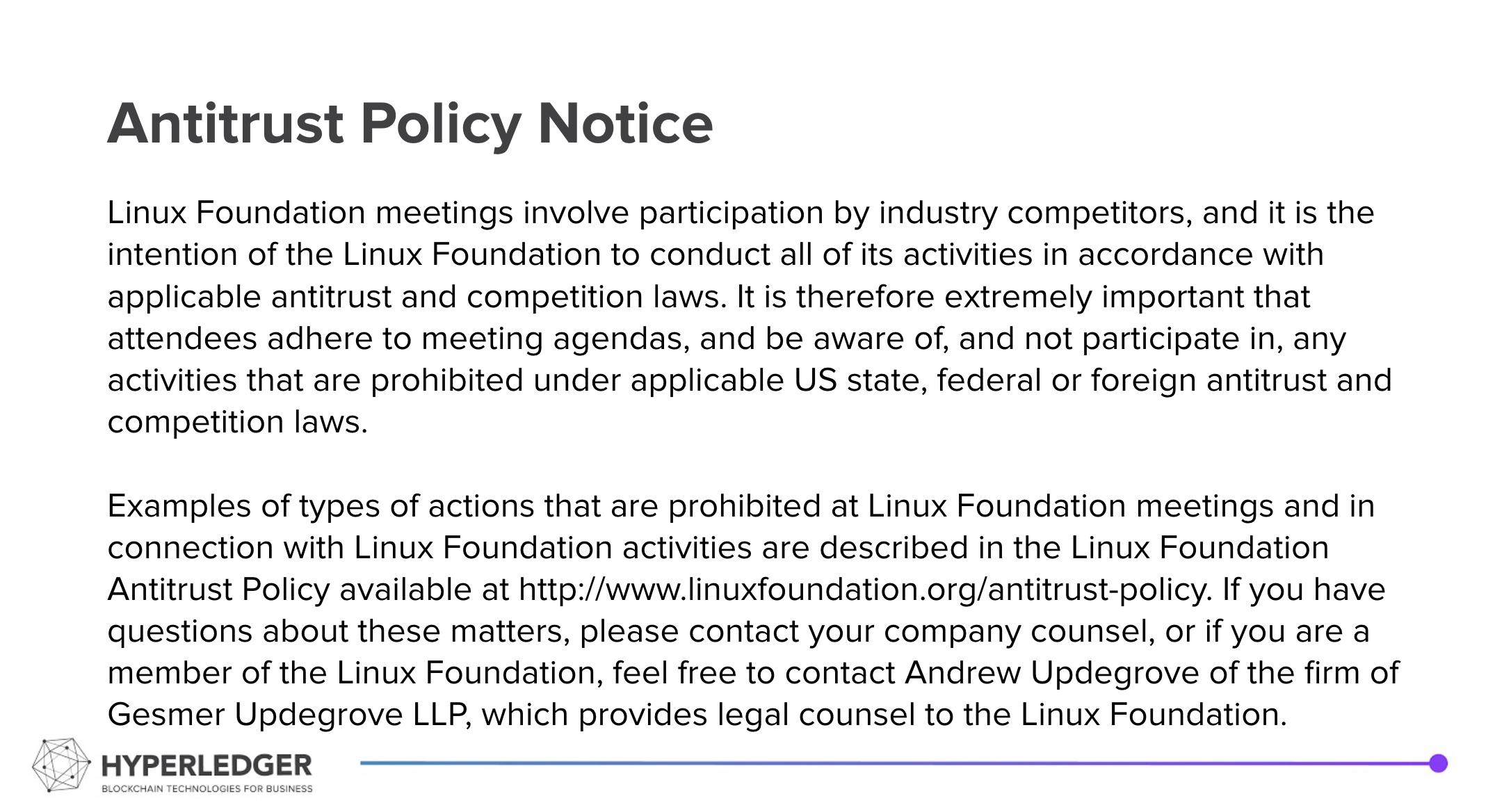2024 06 13 Farm to Plate
Hyperledger is committed to creating a safe and welcoming community for all. For more information please visit the Hyperledger Code of Conduct.
Hyperledger is committed to creating a safe and welcoming community for all. For more information please visit our Code of Conduct: Hyperledger Code of Conduct
Details
Date: Thursday, June 13, 2024
Time: 9:30pm IST / 6:00pm CET / 5:00pm GMT / 12:00pm EDT / 9:00am PDT
Meeting link: https://zoom.us/my/hyperledger.community.backup?pwd=dkJKdHRlc3dNZEdKR1JYdW40R2pDUT09
Zoom Meeting ID: 622 333 6701 Passcode: 475869
Upcoming events
- Sept 9-11, 2024: ASCM Connect 2024, Austin, TX
- Sept 16-18: Linux Foundation Open Source Summit Europe, Vienna, Austria. Includes a "SupplyChainSecurityCon" track.
- Sept 29-Oct. 2, 2024: CSCMP’s EDGE Supply Chain Conference & Exhibition, Nashville, TN
- Feb 10-12, 2025: Manifest, Las Vegas, NV
Announcements
Presentation
Saptarshi Choudhury, VP Product, and Pavan Adhav, Blockchain Architect, of the Farm To Plate team at Paramount Software Solutions, Inc will speak with Suvo Sarkar, founder of Fishmongers, about how Fishmongers is using the Farm to Plate platform tracking live fish, to reduce waste and improve producer incomes in the aquaculture industry.
Farm to Plate uses cutting-edge solutions to empower farmers and other stakeholders in the food supply chain, promote sustainability, ensure food security, and enhance transparency and traceability.
------
- Started in 2020, based in Atlanta, with operations in Asian, Africa, and around the world.
- Grew out of a project of Paramount Software
- Created with government support - national fishery scheme
- Supports multiple SDGs
- Tremendous support for the Blue (water-based) economy from the government.
- 500 lakh (100,000) kilos of fish consumed daily, mostly fresh (50 million kilos)
- There are problems with live fish transportation - mortality
- Dead fish are not fresh - 25% are thrown away, even fish not tossed may be not fit for human consumption
- Fishmongers is providing the safest fish,
- Reduces carbon footprint, due to reduced waste
- All fish is from aquaculture, not reducing wild population
- Offline enabled mobile app to integrate farmers, growers, others, into mainstream supply chain
- Many fishermen do not have access to the internet - creates accessibility problem
- Many languages spoken
- EPCIS 2.0 used to simplify data exchange
- Digitized expiration management enables inventory optimization
- Farm to Plate Architecture
- Hyperledger Fabric 2.2, migrating to 2.5
- Permissioned + private
- Modular architecture, so they can choose which features to use
- Only authorized entities can interact with the network
- Two layers of data validations - business layer and blockchain layer
- Using GS1 standards, to enable interoperability.
- Uses React, Redux, Couch DB, Raft Consensus
- Hosted on AWS Cloud, uses MongoDB database
- Hyperledger Fabric 2.2, migrating to 2.5
- Implementation challenged:
- They needed to link with the market first
- They need to understand stakeholder's existing infrastructure
- Integration is a separate project
- User adoption and training - UX and UI are important
- Pitch using language the users understand
- They do multiple user trainings every month
- When onboarding a new client, they map the client IT landscape, to assess needs, compliance issues
- They're now working on inventory management, other services
- They are now doing sales analytics for supply chain.
- They have not yet enabled payments. They have track-and-trace priorities before they focus on payments
- Consumers can scan a QR code to see the entire supply chain, can give a tip to the farmer (using Stripe, for the financial transaction)
- They are now working to scale the mobile app and web app
- Mobile app is targeted for 10 million users (for individual users (e.g.-farmers, fishermen)
- Web app is targeted for 10,000 users (for enterprise users - B2B)
- Sensors are used for collecting multiple data points
- FishMongers has 8-10 patents on sensors tracking the transportation of live fish, to help keep fish alive and record environmental attributes.
- Farm to Plate collects data, validates that the data is valid for the purpose it is being used.
- Paramount uses GPS trackers to record route, speed, warehouse location, temperature
- Access level:
- Farm to Plate has a model for granting access
- The client decides which level of access different users will have
- Access is customizable
- 2 levels of access from tech level.
- They initially allowed equal access but it was not sustainable. They moved to the 'IBM model', where one user has the ability to onboard other users.
- Warehouse workers must be physically in the warehouse.
- Farm to Plate has a model for granting access
Resources:
Related materials:
Supply Chain 2.0: Navigating the Digital Frontier of Food Distribution - by Farm to Plate founder Pramod Sajja
Attendees
Suvo Srivinasan
Pavan Adhav
Maaz Muhammad Khan
Anandamayee Nanda
Debashish Chakravartgy

